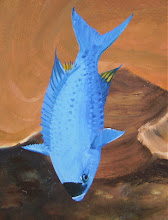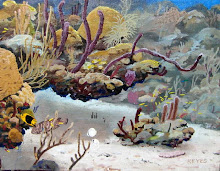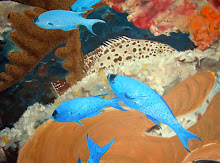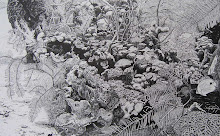
Had to cancel a seminar that I was to attend in Florida next week with Nicholas Simmons, one of the top water media painters in the USA. I'm still on steroids, still tire too easily, and am dizzy at times. And although I am not near 100% OK, I'm a million times better than when I came home early from Greece! With a compromised immune system, I think it best I stay off airplanes, away from strange cities, and just hang around my little Island home.
So here's a photo for you. I don't like to post without a picture of some sort. This is an Elkhorn Coral. They can get quite large, ten feet tall(3meters) This one is about five feet tall. They are one of the faster growing of corals, maybe a half an inch(2cm) a month. They break very easily, as they are quite brittle. Fish like to hang out in their shade, and snorkelling spear fishermen sometimes grab limbs of the Elkhorn, in order to stay still to aim and shoot, and accidentally break them off. I always want to build shelters for the fish designed so fishermen cannot get to the fish!
"When I buy St. Croix next year," is a favorite phrase of mine. If that Genie pops out of the bottle, my first wish would be for twenty trillion dollars! I could buy St Croix and make illegal to do any fishing at all! But people like to eat fish, so what to do? Make Tilapia taste really good, somehow. And make all my friends into millionaires! OK. Silly me.
This coral, along with Staghorn coral, is on the Endangered Species list. They fall prey to plant and soil diseases that have been washed into the sea by poor erosion control on land. Bonaire has some gorgeous stands of the much smaller Staghorn corals, but here in the U.S. Virgin Islands there is almost none left, boooooooo. But then I don't remember seeing Elkhorn in Bonaire, the other Island where I've done a lot of diving.
All the little white "Cheerios" in the water are tiny speck sized critters called Copepods(COH-pee-pods), sort of like crabs or shrimp. Teensie, you could put six or ten on the head of a pin. They are a basic source of food for corals and tiny creatures and newly hatched fish fry. Sometimes there are so many Copepods that they drift around in little brownish clouds on the reef, making it impossible to take photos! I like to think about how many there are, "Millions of billions!"
Today is for working on that sand I started yesterday, try to make it look like sand! haha The corals, fishes and rays will be more fun to do than little shadows and specks in the sand. I'm going to leave some brush strokes, so people ~might~ remember this is paint when they look!

.jpg)



.jpg)
.jpg)
.jpg)
.jpg)
.jpg)
.jpg)
.jpg)
.jpg)
.jpg)
.jpg)
.jpg)
Yea!
ReplyDeleteI'm glad to see you painting again! And doing a big oil one too! (and here I thought you were pretty much committed to watercolor) Great start!
I know you're only beginning it, but I think the sparse blues on there looked kinda cool! About paint quality and lifespan: I'm not very educated about that. I've only been working with oils a little over a year, and I'm just getting ready to move fom "student grade paints" to professional grade. I knew some are warmer/cooler and opaque/transparent, but I didn't know about the different lifespans of different types of colors. I need to know!
Keep on keeping on!
Check out this one: http://karinjurick.blogspot.com/
ReplyDeleteShe's self-taught, been painting for five years now, has a regular recognizable subject, and a growing following. Most of her paintings are one theme, but she paints off topic about 15% of the time.
And, Oboy! You MUST get "The Artist's Handbook" by Ralph Mayer. I've had my copy since 1984, and am still rereading, and re-learning!
The difference between artist's grade colors and student is pigment. Some pigments, Vermillion, Cobalt Blue, Cerulean, are very expenive. I think, I could be wrong, that Cobalt is mined in one place on Earth, the Congo?
Student grade colors have a lot of filler, so your colors mix differently, and often the expensive pigments are substituted with cheaper pigments and mixtures that might not be as permanent.
The 'sparse blues' are in the underpainting sketch that I wasn't able to wash off very well. The Flake White is very transparent! The blue, Pthalo, is a very strong, staining color. You'll learn why in the book. Leave the book around someplace so you can easily pick it up and read a bit.
Remember it's a reference book, like a dictionary. It should be a senior in high school art class subject, and repeated in first year of art school college.
And here's a link to Amazon for this book for you:
http://www.amazon.com/s/ref=nb_ss_gw/002-6080149-8644051?url=search-alias%3Dstripbooks&field-keywords=Mayer%2C+Ralph&x=15&y=25
And, hummm, maybe you've given me an idea of a different way to paint my scenery...
I love the photo. Elkhorn coral - why do "snorkelling spear fishermen" break them off?
ReplyDeleteI like seeing your paintings in progress!
Get healthy!
Oh, well, I didn't make clear that snorkelling fishermen grab a limb in order to stay still and aim at the fish, but by then the fish have all run away. The guys don't mean to break anythng, it just happens.
ReplyDeleteAnd, sheesh, I need to hit the keys harder when I type, a lot of words are misspelled by omission.